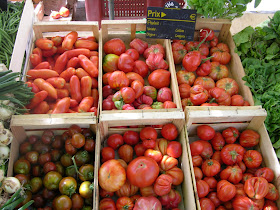
At the moment, the French are all excited about the "rentrée," the re-entry, as this time of year is known. Everyone's back from vacation and getting ready to go back to work and get the kids ready for school. The farmers, on the other hand, have been working all along, and will continue to do so as the crops continue to come in: no rentrée for them.
I haven't been posting pictures from the market for just this reason: it's all pretty much the same stuff these days. In fact, I didn't even go down on Saturday because I checked the stock on hand and decided I didn't really need anything. There's nothing worse than buying something great and having it decay before you can get to it, after all.
But I did get a pleasant surprise last Tuesday: I was looking to buy tomatoes, and there was one guy who's always a reliable source of them, so I was picking out my purchase when I noticed a stack of business cards. Eric Pedebas, they said, "Tomatologue." I stared at that for a minute and decided "tomatologist" would be the proper translation. The stand was manned by M. Pedebas and a young woman, and he was being berated by a woman who was picking up and putting down a number of yellow tomatoes, insisting that she only wanted genuine (variety), while he was trying to make sure she got them. She was being particularly unpleasant, so he asked her to wait while he rang me up.
When I got home, I checked out the URL on the business card. The site isn't the best-designed one I've ever seen (at least it doesn't have some elaborate Flash opening page), but it's packed with tomatoey goodness. The action is hidden from view: clicking the "Mes Tomates" link gets you a page with one link that doesn't work, but clicking "Les Plantes" will get you to a page with a link for "les variétés." That will get you to a page with no fewer than 62 types of tomatoes: cherry, cocktail, medium size (100g - 250g) and large (300g- over a kilogram!). Most of the varieties are described and their history, if known, is recounted -- and illustrated with luscious photographs -- if you click on the photo. He definitely knows his stuff, and his tomatoes are extraordinary: I had a salad the other night that was just lettuce and one of his "chocolate" tomatoes, and it was amazing.
Best of all, this guy is very local. I might even be able to get to his place on the bus. And there's definitely a story here. I'll be patronizing him at the market tomorrow, without a doubt.
* * *
The other agricultural story here is, of course, wine. The Languedoc-Roussillon is France's largest wine-growing area, and this is the time of year when the question begins to loom: what will the harvest be like? This is compounded by a summer that's been hotter than usual, with a couple of big rainstorms coming at odd times.
A wine newsletter I subscribe to has an item on this, headlined "Languedoc: the brutal heatwave accelerates the ripening." The harvest, it says, will be 10 to 12 days earlier than last year, something not seen since 2003. But the big question-mark is the chemistry of the grapes themselves. This left me totally baffled, so I wrote my wine expert, and here's what she had to say:
"Tough stuff. If the phenolic maturity's there, it's not so terrible...but acid's going out the door...lots of winemakers chewing on their nails i'm sure!It's always a balance between sugars (hotter = more sugars produced = less acid in grapes = higher alcohol levels) and phenolic ripeness (the skins and seeds -- where you get your tannins and other flavors in a wine -- are ripe enough to have lost their bitter/green edge).
Like this article points out, sugars mature first then phenols follow -- which is why in hot hot years (or in general every year in the Languedoc), harvest times are a gamble. (Which is why the dudes with the vines in the hills are a bit happier than the dudes with vines on the plains. Altitude helps keep temps moderate; slows ripening and lets those phenols catch up with the pesky sugars.)
Harvest early, you get lots of sugars but not necessarily ripe phenols, resulting in a wine with potentially green edges BUT potentially manageable alco levels. Harvest late, you get waaay more sugars but ripe phenols but potentially a BOMB of a boozy wine that gives people headaches and reminds them why they hate California wines in the first place."
Old hands here remember 2003 as having had some excellent wines, though, and so I'm looking forward to tasting my first summer here when the winemakers release it, encased in glass.
* * *
Meanwhile, if you haven't read this lovely piece about eating in France by the great Roger Cohen in the New York Times today, spend a minute or two and do so. He's absolutely right.
No comments:
Post a Comment